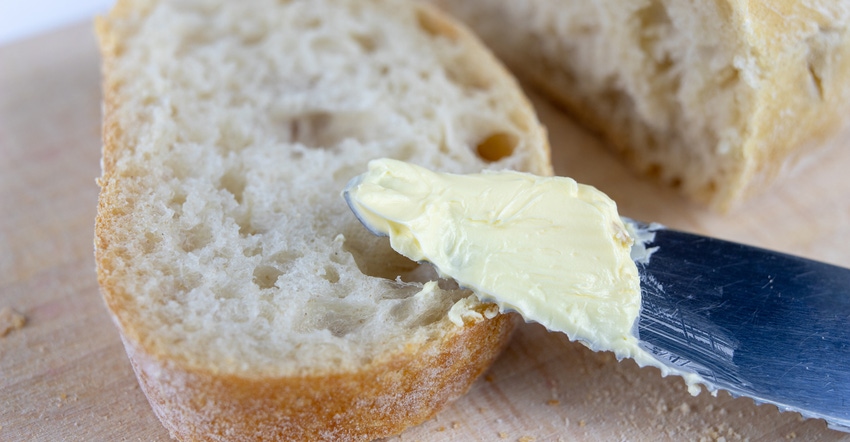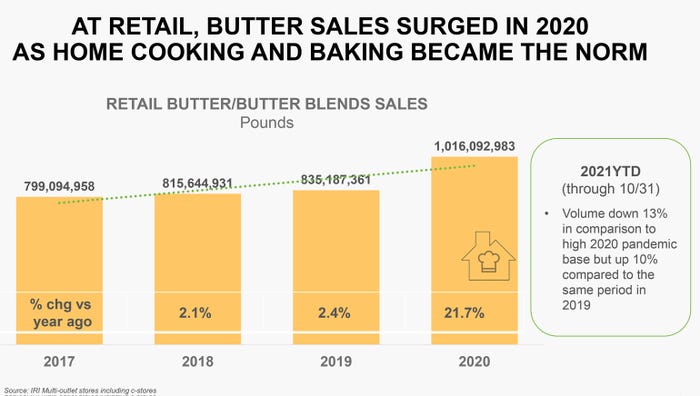
Pop a slice of hearty bread in the toaster today, spread on a generous chunk of butter and savor it melting. Mmmm. Grab a hot beverage and enjoy. It’s National Butter Day!
Yes, butter finally has its own national day of recognition, thanks to the dairy cooperative Associated Milk Producers Inc. in New Ulm, Minn. There have been numerous self-proclaimed butter days in the past, but they have been temporary and regional.

Sarah Schmidt, AMPI vice president of public affairs, said the cooperative became aware of the lack of national celebration while working on marketing plans last summer for its Dinner Bell Creamery-brand butter products. Staffers did a Google search and found occasional pronouncements for butter, and they also came across other dairy-related days of note. June 1 is World Milk Day. Cheese is celebrated on June 4. And all of July is National Ice Cream Month. AMPI also checked the online National Day Calendar and nothing was listed.
To further clarify, butter — no pun intended, they checked with the ultimate source.
“We reached out to the American Butter Institute and they confirmed: There was no official National Butter Day on record,” Schmidt says.
Armed with that knowledge, AMPI staff contacted folks at National Day Calendar and worked with them to establish an official listing for National Butter Day. You can check it out here.
AMPI chose Nov. 17 as National Butter Day to mark the upcoming holiday season.
“We felt celebrating butter at the beginning of the holiday cooking and baking season would be fun and very appropriate,” Schmidt says. “Butter is a key ingredient in so many dishes and desserts enjoyed this time of year.”
Nov. 17 also is National Homemade Bread Day.

“Nothing goes better with bread than butter!” Schmidt adds.
In recognition of National Butter Day, AMPI encourages everyone to celebrate by buying U.S.-made butter, using it in cooking and baking, and by shopping for butter-rich treats. You can add to the celebration today by posting on social media with the hashtag: #NationalButterDay.
Fun facts about butter
Here are several interesting stories and facts about butter, gathered from AMPI, the American Butter Institute and the Butter Journal.
• According to legend, butter was discovered by accident some 9,000 years ago, when a Persian goat herder transported milk in animal-skin pouches along a bumpy road. As the milk sloshed back and forth, it turned into butter. When the goat herder discovered the churned milk, he considered the milk ruined. A taste test quickly dispelled that thought.
• Butter was the fat of choice for the tribes of Northern Europe. The Greek poet Anaxandrides referred to barbarians from the north as “butter-eaters.”
• Climate likely played a role in regional tastes, since cool weather at northern latitudes allowed people to store butter longer.
• By the 12th century, butter business was booming across northern Europe. Records show that Scandinavian merchants exported tremendous amounts each year, making the spread a central part of their economy, according to the Butter Journal. Butter was so essential to life in Norway, for example, that the king demanded a full bucket every year as a tax.
• Until the 1600s, butter-eating was banned during Lent. Without access to cooking oils, meal-making during the weeks preceding Easter was a struggle for Northern European Christians. Wealthy folks often paid the church a hefty tithe for permission to eat butter during the month of self-denial. These tithes helped finance the building of the third tower of Rouen Cathedral in France — the Tour de Beurre — or the “Butter Tower” in French.
• Butter contains up to 80% butterfat. It is made by churning fresh or fermented cream or milk to separate the butterfat from the buttermillk . Butter consists of butterfat , milk proteins and water.
• There are several types of butter. Unsalted butter is good for cooking and baking. Clarified butter, made by melting and discarding the milk solids and water, is often served as a dipping sauce for shellfish and other seafood. Clarified butter doesn’t burn at high temperatures, so it is also a good choice for frying and sautéing. Cultured butter, made from cultured cream, offers a rich, complex flavor. It is ideal for baking because the lower moisture content produces flakier pastries and fluffier cakes. European-style butter is made from cream that is churned more slowly and for a longer time. It has a butterfat content of at least 82%. Whipped butter has nitrogen gas incorporated into it to create a soft spread.
• Many recipes recommend bringing butter to room temperature first so it can mix better with other ingredients. The exception is pie crust. You need cold butter to get a flaky pie crust.
• Today, the average American consumes 6.3 pounds, or 25 sticks, of cow’s milk butter annually.
About the Author(s)
You May Also Like






